Unlike knitted items, crochet patterns, denser, and sometimes even more rigid. But the advantages of such fabrics are that they are less susceptible to stretching and shrinkage when worn, wet and heat treated. The patterns, as well as their detailed descriptions, considered in this article, represent only a small part of the diversity of the world of handicrafts.
Descriptions of schemes
The opposite of openwork crochet patterns are dense ones, they are suitable for knitting warm winter clothes.
Dense crochet patterns, the diagrams of which are presented below, are widely used by modern craftswomen.
They look very beautiful when knitting women's cardigans, children's coats, berets, snoods, blankets, bedspreads and even rugs. Lush columns give the fabric relief and density. The patterns of this group are not complicated if you carefully study the diagram and understand the knitting process.
Pattern with lush columns
Before proceeding to the description, it is necessary to consider the symbols of the signs. schemes (they have similar designations in all schemes and are standard):
| Designation | Transcript |
| Ellipse | Indicates an air loop. |
| Cross or plus | Slip stitch or single crochet. |
| Long line with 2 slashes at the top | Double crochet or double crochet. |
For this scheme, these designations are sufficient.

What you need to pay close attention to is how many loops are included in the pattern rapport. It is recommended to do this, since it is necessary to correctly calculate how many loops should be cast on for a part of the product, without violating the integrity of the pattern and ease of work.
Almost every pattern has a symbol with the letter "R" or "P". This is the rapport designation. In this pattern, the rapport of the pattern includes 2 loops. To cast on loops when knitting, you should stick to a number that is a multiple of 2.
Now you can start the knitting process itself. It consists of alternating rows consisting of arcs in one air loop, which are secured with 2 single crochets in a chain, and lush columns, between which 1 air loop is knitted. Located one above the other, convex columns create the effect of a relief path, which looks very beautiful in the finished product.
Multicolor pattern
The original pattern, the diagram of which is presented below, has elements of openwork, but they are almost invisible in the finished fabric. It can be made in several colors, knitted in two colors or in one color. In any case, the pattern will look beautiful in children's products, cardigans, blankets.
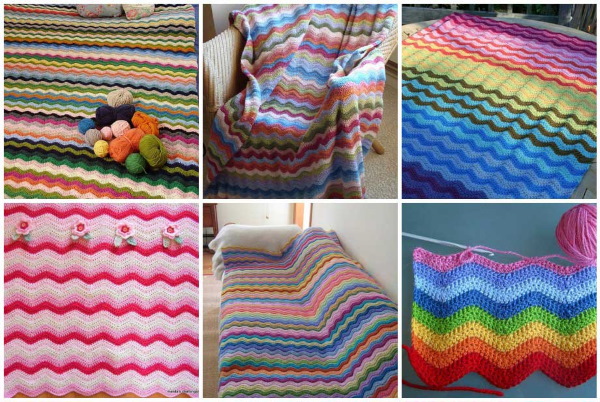
To knit such a pattern, you should first calculate the rapport. In this pattern it is equal to 12 loops. This means that to maintain the integrity of the pattern it is necessary to cast on as many loops that are divisible by 6. An additional symbol in this pattern will be a column with 1 yarn over (sc 1/n), and a column sc is marked +.
Description of knitting
The pattern height rapport is 2 rows, which, repeated in a checkerboard pattern, create the effect of small fan-shaped bulges, which looks very attractive in the fabric.
Knitting pattern:
- The 1st row is completed by alternating 5 single crochets and a triple crochet with 1 crochet, between which a pair of air loops are knitted, leaving 3 air loops between them.
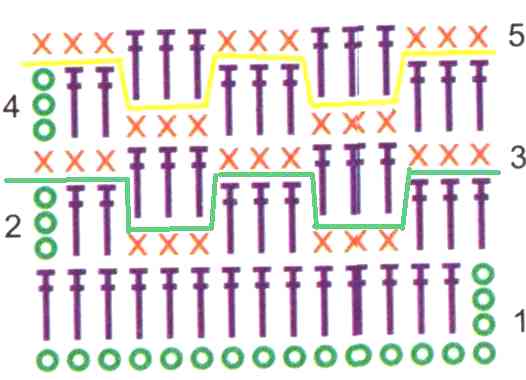
- The second row is knitted by alternately knitting 3 single crochets into the 5 lower ones and 9 single crochets under the arches of air loops.
- Then the pattern is repeated, but the “fans” are shifted to the middle single crochet below the knitted row.
Pattern with transitions
The dense pattern of this type, crocheted, has a more sparse structure. It consists of alternately using fragments of different patterns. It can be either single-color or multi-color. It is used in knitting dresses, skirts, scarves. In it, the rapport is calculated based on the first pattern. In this case, it will be equal to 3.
Description of knitting
Step by step process of creating a pattern:
- The 1st row is made with double crochet stitches. After that, several rows are knitted (at individual request) and are knitted with arcs of air loops. Their number and places of attachment to the bottom row can also be different.
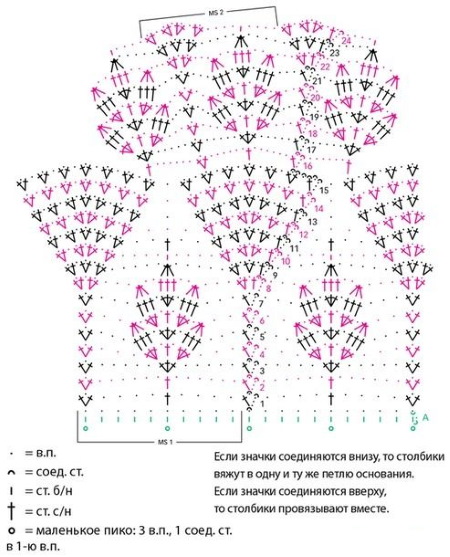
- Then the next pattern begins, consisting of triple treble crochets, knitted under the arches of air loops.
- The following rows are knitted in the same way, but under the spaces between the triple columns of the row below. Their number is also determined individually.
- In the last row of the pattern, additional air loops are introduced, located one by one between the 1st, 2nd and 3rd columns with 1 yarn of the triple column. This is necessary to make the transition to knitting the next pattern.
- Now you should knit several rows of the transition itself, the first of which is made from the arcs of air loops, secured in the central column with 1 yarn over of the row below.
- In the next row, the pattern is evened out by decreasing the length of the arcs.
- Then a row of double crochet stitches is made into the next chain stitch of the row below.
- Next, a new pattern begins. It consists of successive alternation of a triple column with 1 yarn over with 1 such column, which is knitted into every 2nd column of the lower row. Again, the height of the pattern is determined at will.
- This pattern ends with a row of 1 yarn overs in the previous one. It is also a transitional one for knitting the next pattern.
There are many options for selecting patterns, as well as transitions from one to another. Here everything depends on the choice, taste and imagination of the needlewoman
Pattern "Wave"
The presented scheme shows a pattern of medium density. This is due to the presence of gaps in it, obtained when knitting through a loop. It is simple to perform, but has a very beautiful appearance.
Products made with this pattern can be multi-colored, two-colored and single-colored. It is used in knitting tunics, blouses, sweaters, berets, snoods, scarves, blankets. To start knitting, you need to determine the number of loops of the rapport. In this pattern, it is 18.
Description of knitting
The presented pattern is very simple to perform, but very beautiful in the finished product. The height of the rapport is 2 rows. The main thing is to be careful that the vertical lines are even.
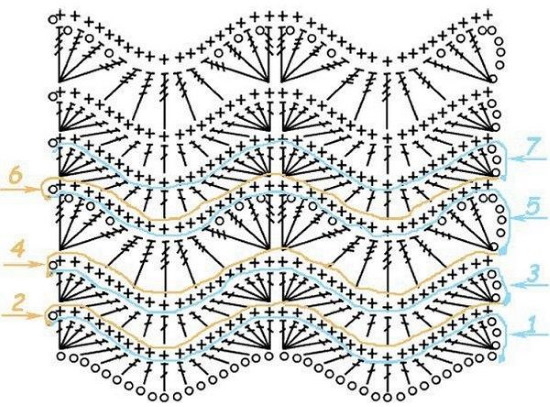
Step by step knitting:
- The 1st row is knitted in a sequential alternation of 6 double crochet stitches with 1 yarn over into the next subsequent chain stitch and 5 single crochet stitches with 1 yarn over, which are carried out into the next second chain stitch.
- 2nd row - only single crochets. The following rows are analogous to the previous ones. The central columns of the trough and the top of the "wave" can serve as a guide for correct knitting.
There is one nuance in the Wave pattern that can change its appearance. If, when knitting a column with 1 yarn over, you grab the working thread only by inserting the hook behind the back of the loop of the row below, then on the front side of the pattern, a wavy line created by rows of single crochets will be clearly visible.
Pattern "Bumps"
Dense crochet patterns (schemes of some are given in the text) represent a voluminous fabric with clearly defined "bumps". This method will look very beautiful in children's sets consisting of a coat and a hat, cardigans for adult women will be distinguished by the originality of the idea.
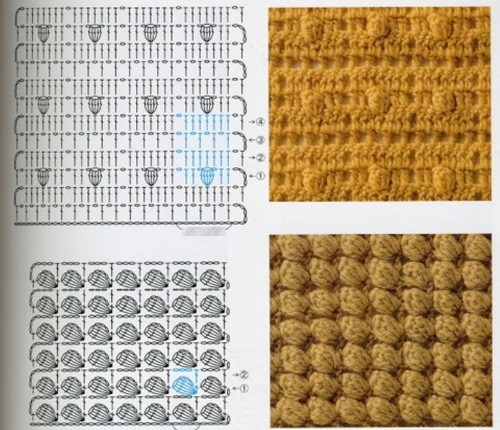
Based on the diagram, unfamiliar components appeared in it: a convex single crochet and the already familiar lush column, but consisting of 6 sts with 1/n. 4 loops are the rapport of this pattern.
Description of knitting
The pattern repeat is 4 rows high. It includes 2 identical rows, arranged in a checkerboard pattern:
- In the 1st row, 3 single crochets and a chain stitch are alternated, which are performed by leaving a chain stitch.
- The 2nd row consists of alternately connected lush column, consisting of 6 columns with 1 yarn and a convex column, which is knitted not in a loop, but in the girth of the column of the lower row before work. The columns are connected to each other by an arc of 2 air loops.
- The next row is alternately making 2 single crochets and 1 chain stitch.
- The next row is an exact analogy of the second, with the only difference being that the columns are arranged in a checkerboard pattern and the raised single crochet is knitted around the lush column in front of the work.
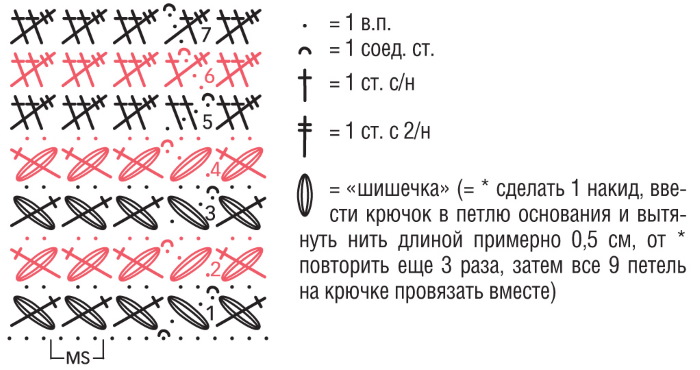
Then everything repeats itself.
Pattern "Shells"
One of the list of dense crochet patterns is "Shells". It is simple and original, looks beautiful in products of any purpose, from things for newborns to bedspreads. The pattern rapport of this scheme is 8.
Description of knitting
The height of the pattern rapport is 2 rows, which are a repetition of the same row in a checkerboard pattern.
The pattern is made by repeating small "fans" consisting of 6 double crochet stitches, in the middle of which an air loop is knitted. Such a bunch of stitches is made in the next 8th loop of the chain with an intermediate fastening in the next 4th loop.

The next rows are done similarly to the first, but the “fan” is knitted from a single crochet of the row below, and is secured in the air loop of the top of the bundle.
Rice Fields Pattern
Dense crochet patterns (the patterns are very simple and do not require special skills) are applicable in warm jackets, coats and rugs. The rapport of this pattern is 2 loops.
Description of knitting
The height rapport of this pattern is 2 rows:
- The 1st row is a series of double single crochet stitches. The difference is in the knitting process itself. The short single crochet stitch is knitted normally, and the second, extended one is knitted in 2 stages. First, one captured working thread is knitted, and then the 2 remaining loops on the hook are knitted.

- In the next row, these columns change places and are knitted only into the elongated columns of the row below.
Tunisian Motif
Tunisian crochet is a technique that imitates a dense fabric knitted with knitting needles. Unlike regular crochet, this technique uses a long hook because all the knitted loops remain on it during knitting.
Description of knitting
The height of the pattern repeat for this technique is 2 rows:
- After the chain is cast on, a loop is caught on the hook from each of its loops, but not knitted. This is done until the end of the row.
- Then the work is not turned as in normal crochet, but is crocheted from end to beginning.
- The edge loop is knitted alone, capturing the working thread. The subsequent loops are knitted in pairs until the beginning of the row.
- Without turning the work, loops are again cast on to the hook from the loops obtained when knitting the previous row.
- Then everything repeats itself.
Pattern "Scales"
Dense crochet patterns, the schemes of which seem intricate, are actually not difficult to perform. "Scales" is a record holder among all similar knitting options in terms of yarn consumption. The knitted "scales" slightly overlap each other, giving an attractive volume and relief to the product.
This method is used for knitting coats, envelopes for newborns, children's clothes and blankets. The rapport of this scheme is 6 loops. Therefore, to calculate the set of loops, it is necessary to take into account that the number of loops collected must be divisible by 3.
Description of knitting
The height rapport of this pattern consists of 4 rows, of which the second 2 repeat the first 2, only located in a checkerboard pattern relative to each other. If we describe this pattern figuratively, it is a base, that is, a grid, the vertical partitions of which are tied with a certain number of double crochets, creating a scale effect.
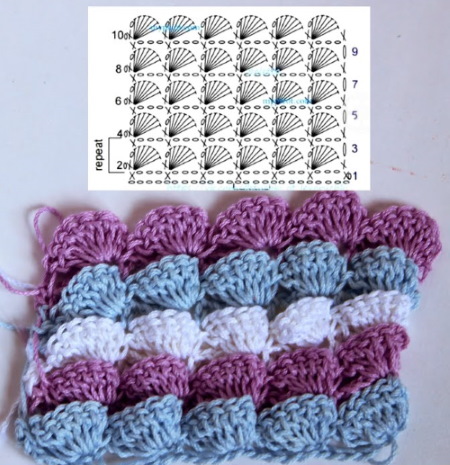
If you look at the presented scheme in more detail, there is nothing complicated in it. The main thing is to understand in which direction each subsequent row should be knitted. It may not be entirely convenient to perform the initial rows, but then this drawback will go away by itself.
Step by step knitting:
- To knit the 1st row, you should alternately make double and single crochets with 1 yarn over, between which 1 air loop is knitted.
- It is necessary to make columns in every 3rd loop of the chain.
- When working the next row, it is best to turn the work vertically first.
- Nuance: so that the outer scale is not tightened, but looks more beautiful, it is recommended to knit 3 air loops and only then perform 5 double crochets. After that, knit 1 air loop and turn the work again 180 degrees.
- Continue knitting the second part of the scale with 5 double crochet stitches. Do this until the end of the row, not forgetting to knit 3 air loops again at the end. This nuance is applicable only in those rows in which the scales are extreme, in others there is no need to do this.
Relief pattern
The presented relief pattern is both dense and openwork. Made from loose and thick yarn, it will beautifully "lay" in a figured, relief pattern.
It can be used in various knitted items and household items. The rapport of this pattern is 8 loops.
Description of knitting
The height of the rapport of this pattern is 4 rows, which are repeated in pairs in a checkerboard pattern:
- The beginning of the work consists of successive alternation of triple lush columns, separated from each other by 2 air loops, which are secured with single crochets through an air loop in every 4th loop of the chain.
- In the 2nd row there is an alternation of triple columns with 1 yarn over, secured through 2 air loops with a single crochet into the top of the central lush column of the row below.
- The next row is similar to the first, with the difference that the triple lush columns are knitted from the central triple column of the previous row, and secured in a single crochet.
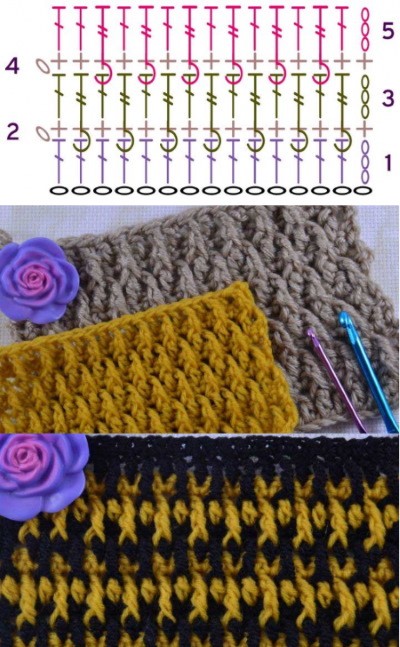
Then all rows are repeated.
Pattern "Tourniquets"
The crochet pattern "Bands" imitates the relief longitudinal stripes knitted with knitting needles. It is denser and is not so susceptible to deformation, very easy to perform, the main thing is to understand how to knit the front and back loops when crocheting. In this pattern, the rapport is 6 loops. It depends on the width of the cords in the pattern.
Description of knitting
The repeat of this pattern in height is 2 rows. The width and height of the cords are determined individually, depending on the main pattern or the product being manufactured.
To make cables, you only need to know how to knit front and back stitches. To do this, you should knit subsequent stitches not into the loops of the rows below, but around them in front of the work (front) and behind the work (back).
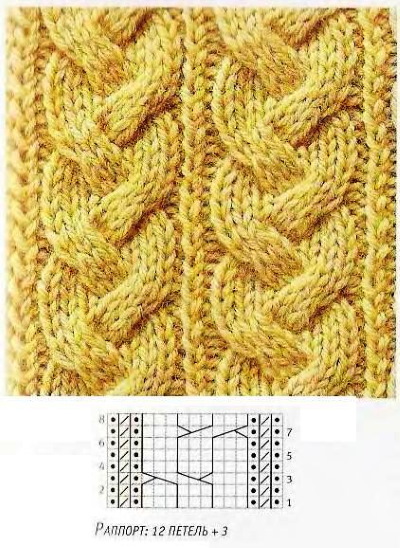
In the 1st row, there may be some inconvenience when performing. But with further knitting, the pattern itself will tell you which column to make.
Pattern "Braids"
This dense pattern also imitates similar "braids" knitted with knitting needles. It is durable, original and practical. It is used mainly when knitting men's and women's sweaters, stoles.
This pattern has a new designation. It is a hook with 2 cross lines. Its meaning is a front column with 2 yarns. The rapport again depends on the width of the "braids". In this pattern it is 8.
Description of knitting
The execution of this pattern requires increased attention. This is due to the fact that in the front and back rows the columns change to the opposite ones. But these difficulties will only be encountered at the beginning of the work. Then, following the pattern, it will already be clear which columns to use.
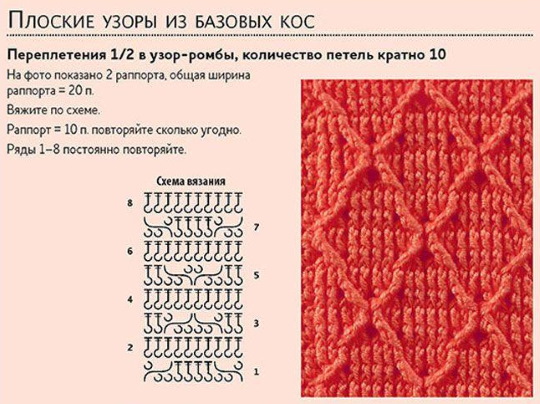
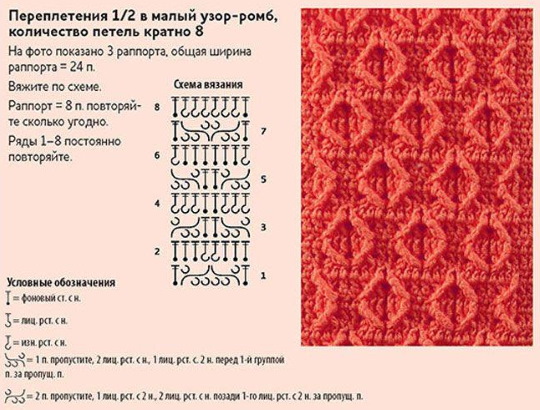
The height and width of the braids being knitted are arbitrary and are selected individually, based on the main pattern and the product being made:
- The beginning of the work consists of knitting a row of single crochet stitches.
- In the next row, the location is determined and the braid or several braids are calculated. In this scheme, there are 2 of them. They consist of 6 columns.
- The 3rd row (purl) begins with 2 front stitches, then 6 back stitches of the 1st braid, 6 back stitches of the 2nd braid and ends with 2 front stitches again.
- In the 4th row, the braid stripes are crossed. First, 2 purl stitches are knitted, then 3 front stitches are knitted around the 4th, 5th and 6th stitches of the row below, after which 3 front stitches with 1 yarn over are knitted again, but around the 1st, 2nd and 3rd stitches. The row ends with 2 purl stitches.
Then everything is done similarly to the previous description.
Using the dense crochet patterns and diagrams for them, you can replenish the wardrobe of the whole family, as well as update the interior and create coziness in your home.
Video about knitting dense patterns
Dense crochet patterns - knitting patterns for a simple pattern:
